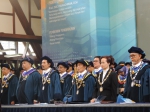ATRIA 2024 Talkshow: Creating Intuitive and Comfortable Spaces Using UX Approach in Architecture
By Chysara Rabani - Mahasiswa Teknik Pertambangan, 2022
Editor Anggun Nindita

BANDUNG, itb.ac.id – The Architecture Study Program of Institut Teknologi Bandung (ITB) hosted a talk show themed “Human-Centered Design: Bringing UX Approaches into Design”. This event, which serves as a closure of the ATRIA 2024 series, took place at the East CC Auditorium on Saturday (28/9/2024).
The talk show was moderated by ITB Architecture lecturer Dr. Eng. Mochamad Donny Koerniawan, S.T., M.T., and featured three distinguished speakers, namely Lead Product Designer at SixtyTwo, Ivan Afandi; Architect and Founder of Gugus Gagas Studio, Widi Cahya Yudhanta, M.Sc.; and Principal of Formologix Laboratory, Ar. Dani Hermawan, M.Arch, IAI.
Ivan Afandi explained that UX is the process of designing products to be intuitive, efficient, and enjoyable for users. UX is essential because it is grounded in user experience. Key principles of UX include guiding users on how to interact with the product, providing clear control, and facilitating easy access to information.
He noted that advancements in technology, such as AI, AR, and VR, present new opportunities and challenges in maintaining the value of design. As a result, designers must consider numerous factors such as personalization, inclusivity, immersion, and ethical considerations.
"Good design prevents users from experiencing frustration and errors. Designers must understand complex cultural contexts and strike a balance between innovation and tradition," Ivan stated.
Meanwhile, Widi Cahya Yudhanta, M.Sc., emphasized that human sensors and senses are profoundly affected by space. The eyes guide human movement, the nose detects surrounding aromas, and cognition shapes how people respond to a space.
Designs must be comfortable because spaces directly influence the user's behavior. On this matter, the virtual world can help humans project the potential impacts of a building’s design. This is the first step in ensuring that the design meets user needs.
"We must understand human habits and needs before designing spaces. While spaces can be engineered, people cannot. Thus, it is essential to create synergy between humans and their environments," Widi explained.
On the other hand, Ar. Dani discussed how UX acts as a catalyst in computational design. He highlighted that UX accelerates the design process by helping transition from conventional methods.
According to him, design is a process that transforms possibilities into reality. Once a design is realized, it requires continuous evaluation and readjustment. Typically, this process is carried out step by step, which often leads to indirect modifications. However, UX enables designers to make direct and responsive changes.
"UX is highly beneficial for designers. However, it’s important to recognize that the product is not the final result. Ongoing evaluation is necessary to enhance a building’s performance over time," he added.
The event concluded with remarks from the Head of ITB’s Master’s and Doctoral Programs in Architecture, Dewi Larasati, S.T., M.T., Ph.D., who encouraged participants to use ATRIA as a source of inspiration to move forward together. She also emphasized that collaboration between architects, designers, and other communities can enhance the complexity and utility of architecture.
Reporter: Chysara Rabani (Mining Engineering, 2022)
Translator: Hanifa Juliana (Urban and Regional Planning, 2020)
Editor: Anggi Nurdiani (Management, 2024)

.jpg)
.png)
.jpg)
.jpg)
.jpg)


